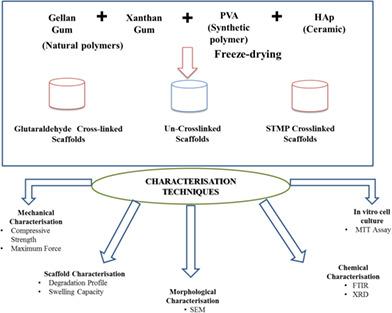当前位置:
X-MOL 学术
›
J. Biomed. Mater. Res. Part B Appl. Biomater.
›
论文详情
Our official English website, www.x-mol.net, welcomes your
feedback! (Note: you will need to create a separate account there.)
Crosslinking of gum-based composite scaffolds for enhanced strength and stability: A comparative study between sodium trimetaphosphate and glutaraldehyde.
Journal of Biomedical Materials Research Part B: Applied Biomaterials ( IF 3.2 ) Pub Date : 2020-06-03 , DOI: 10.1002/jbm.b.34640 Mugdha Makrand Joglekar 1 , Devlina Ghosh 1 , Dhivyaa Anandan 2 , Puja Yatham 3 , Rahul Dev Jayant 4 , N Arunai Nambiraj 2 , Amit Kumar Jaiswal 2
Journal of Biomedical Materials Research Part B: Applied Biomaterials ( IF 3.2 ) Pub Date : 2020-06-03 , DOI: 10.1002/jbm.b.34640 Mugdha Makrand Joglekar 1 , Devlina Ghosh 1 , Dhivyaa Anandan 2 , Puja Yatham 3 , Rahul Dev Jayant 4 , N Arunai Nambiraj 2 , Amit Kumar Jaiswal 2
Affiliation

|
Tissue engineering is one of the potential fields in the domain of regenerative medicine. Engineered scaffolds are an excellent substitute for the conventional use of bone grafts as they are biocompatible, economic, and provide limitless supply with no risk of disease transmission. Gum‐based scaffolds present a good scope for studying tissue‐engineering models and analyzing controlled drug delivery. Uniform blending of the gums and the presence of the optimal concentration of appropriate crosslinkers are very crucial for biodegradability nature. Gum‐based scaffolds containing gellan gum, xanthan gum, polyvinyl alcohol, and hydroxyapatite, cross‐linked with either glutaraldehyde (GA) or sodium trimetaphosphate (STMP) were fabricated to study the efficiency of crosslinkers and were characterized for degradation profile, swelling capacity, porosity, mechanical strength, morphology, X‐ray diffraction, Fourier‐transform infrared, and in vitro biocompatibility. Scaffolds crosslinked with STMP exhibited higher degradation rate at Day 21 than scaffolds crosslinked with GA. However, higher compressive strength was obtained for scaffolds cross‐linked with STMP signifying that they have a better ability to resist compressive forces. Superior cell viability was observed in STMP‐crosslinked scaffolds. In conclusion, STMP serves as a better crosslinker in comparison to GA and can be used in the fabrication of scaffolds for bone tissue engineering.
中文翻译:

交联胶基复合支架以提高强度和稳定性:三偏磷酸钠和戊二醛之间的比较研究。
组织工程是再生医学领域的潜在领域之一。工程支架是传统骨移植物的极好替代品,因为它们具有生物相容性、经济性,并提供无限供应,没有疾病传播的风险。基于胶的支架为研究组织工程模型和分析受控药物递送提供了良好的范围。树胶的均匀混合和适当交联剂的最佳浓度的存在对于生物降解性非常重要。制造含有结冷胶、黄原胶、聚乙烯醇和羟基磷灰石的胶基支架,与戊二醛 (GA) 或三偏磷酸钠 (STMP) 交联,以研究交联剂的效率,并表征降解曲线、溶胀能力、孔隙率,机械强度、形态、X 射线衍射、傅里叶变换红外和体外生物相容性。与用 GA 交联的支架相比,用 STMP 交联的支架在第 21 天表现出更高的降解率。然而,与 STMP 交联的支架获得了更高的抗压强度,这表明它们具有更好的抗压能力。在 STMP 交联支架中观察到优异的细胞活力。总之,与 GA 相比,STMP 是一种更好的交联剂,可用于制造骨组织工程支架。与 STMP 交联的支架获得了更高的抗压强度,表明它们具有更好的抗压能力。在 STMP 交联支架中观察到优异的细胞活力。总之,与 GA 相比,STMP 是一种更好的交联剂,可用于制造骨组织工程支架。与 STMP 交联的支架获得了更高的抗压强度,表明它们具有更好的抗压能力。在 STMP 交联支架中观察到优异的细胞活力。总之,与 GA 相比,STMP 是一种更好的交联剂,可用于制造骨组织工程支架。
更新日期:2020-06-03
中文翻译:

交联胶基复合支架以提高强度和稳定性:三偏磷酸钠和戊二醛之间的比较研究。
组织工程是再生医学领域的潜在领域之一。工程支架是传统骨移植物的极好替代品,因为它们具有生物相容性、经济性,并提供无限供应,没有疾病传播的风险。基于胶的支架为研究组织工程模型和分析受控药物递送提供了良好的范围。树胶的均匀混合和适当交联剂的最佳浓度的存在对于生物降解性非常重要。制造含有结冷胶、黄原胶、聚乙烯醇和羟基磷灰石的胶基支架,与戊二醛 (GA) 或三偏磷酸钠 (STMP) 交联,以研究交联剂的效率,并表征降解曲线、溶胀能力、孔隙率,机械强度、形态、X 射线衍射、傅里叶变换红外和体外生物相容性。与用 GA 交联的支架相比,用 STMP 交联的支架在第 21 天表现出更高的降解率。然而,与 STMP 交联的支架获得了更高的抗压强度,这表明它们具有更好的抗压能力。在 STMP 交联支架中观察到优异的细胞活力。总之,与 GA 相比,STMP 是一种更好的交联剂,可用于制造骨组织工程支架。与 STMP 交联的支架获得了更高的抗压强度,表明它们具有更好的抗压能力。在 STMP 交联支架中观察到优异的细胞活力。总之,与 GA 相比,STMP 是一种更好的交联剂,可用于制造骨组织工程支架。与 STMP 交联的支架获得了更高的抗压强度,表明它们具有更好的抗压能力。在 STMP 交联支架中观察到优异的细胞活力。总之,与 GA 相比,STMP 是一种更好的交联剂,可用于制造骨组织工程支架。











































 京公网安备 11010802027423号
京公网安备 11010802027423号